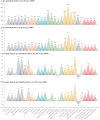Measuring the global disease burden of polycystic ovary syndrome in 194 countries: Global Burden of Disease Study 2017
- PMID: 33501984
- PMCID: PMC7970729
- DOI: 10.1093/humrep/deaa371
Measuring the global disease burden of polycystic ovary syndrome in 194 countries: Global Burden of Disease Study 2017
Abstract
Study question: What is the current burden of polycystic ovary syndrome (PCOS) at the global, regional, and country-specific levels in 194 countries and territories according to age and socio-demographic index (SDI)?
Summary answer: Slight increases in age-standardized incidence of PCOS and associated disability-adjusted life-years (DALYs) were evidenced among women of reproductive age (15-49 years) from 2007 to 2017 at the global level, and in most regions and countries.
What is known already: No detailed quantitative estimates of the PCOS incidence and DALYs by age and SDI in these 194 countries and territories have been published previously.
Study design, size, duration: An age- and SDI-stratified systematic analysis of the PCOS incidence and DALYs across 194 countries and territories has been performed.
Participants/materials, setting, methods: We used data from the Global Burden of Diseases, Injuries and Risk Factors Study (GBD) 2017 to estimate the total and age-standard PCOS incidence rates and DALYs rates among women of reproductive age in both 2007 and 2017, and the trends in these parameters from 2007 to 2017.
Main results and the role of chance: Globally, women of reproductive age accounted for 1.55 million (95% uncertainty intervals (UIs): 1.19-2.08) incident cases of PCOS and 0.43 million (0.19-0.82) associated DALYs. The global age-standardized PCOS incidence rate among women of reproductive age increased to 82.44 (64.65-100.24) per 100 000 population in 2017, representing an increase of 1.45% (1.43-1.47%) from 2007 to 2017. The rate of age-standardized DALYs increased to 21.96 (12.78-31.15) per 100 000 population in 2017, representing an increase of 1.91% (1.89-1.93%) from 2007 to 2017. Over the study period, the greatest increase in the age-standardized PCOS incidence and DALYs rates were observed in the middle-SDI and high-middle SDI regions, respectively. At the GBD regional level, the highest age-standardized incidence and DALY rates in 2017 were observed in Andean Latin America, whereas the largest percentage increases in both rates from 2007 to 2017 were observed in Tropical Latin America. At the national level, Ecuador, Peru, Bolivia, Japan, and Bermuda had the highest age-standardized incidence rates and DALYs rates in both 2007 and 2017. The highest increases in both the age-standardized incidence rates and DALYs rates from 2007 to 2017 were observed in Ethiopia, Brazil, and China.
Limitations, reasons for caution: Although the GBD (2017) study aimed to gather all published and unpublished data, the limited availability of data in some regions might have led to the estimation of wide UIs. Additionally, the PCOS phenotype is complicated and the diagnostic criteria are constantly changing. Consequently, the incidence of PCOS might have been underestimated.
Wider implications of the findings: Knowledge about the differences in the PCOS burden across various locations will be valuable for the allocation of resources and formulation of effective preventive strategies.
Study funding/competing interest(s): The study was supported by grants from the Innovative Talent Support Plan of the Medical and Health Technology Project in Zhejiang Province (2021422878), Ningbo Science and Technology Project (202002N3152), Ningbo Health Branding Subject Fund (PPXK2018-02), Sanming Project of Medicine in Shen-zhen (SZSM201803080), and National Social Science Foundation (19AZD013). No potential conflicts of interest relevant to this article were reported.
Trial registration number: N/A.
Keywords: disability-adjusted life-years; global burden of disease; incidence; polycystic ovary syndrome; socio-demographic index.
© The Author(s) 2021. Published by Oxford University Press on behalf of European Society of Human Reproduction and Embryology.
Figures



References
-
- Ahmad OB, Boschi-Pinto C, Lopez AD, Murray CJ, Inoue M. Age standardization of rates: a new WHO standard. Geneva: World Health Organization; 2001. https://www.who.int/ healthinfo/paper31.pdf.
-
- Apter D. Endocrine and metabolic abnormalities in adolescents with a PCOS-like condition: consequences for adult reproduction. Trends Endocrinol Metab 1998;9:58–61. - PubMed
-
- Azziz R. Introduction: determinants of polycystic ovary syndrome. Fertil Steril 2016;106:4–5. - PubMed
-
- Baba T, Endo T, Honnma H, Kitajima Y, Hayashi T, Ikeda H, Masumori N, Kamiya H, Moriwaka O, Saito T. et al. Association between polycystic ovary syndrome and female-to-male transsexuality. Hum Reprod 2007;22:1011–1016. - PubMed
-
- Baba T, Endo T, Ikeda K, Shimizu A, Honnma H, Ikeda H, Masumori N, Ohmura T, Kiya T, Fujimoto T. et al. Distinctive features of female-to-male transsexualism and prevalence of gender identity disorder in Japan. J Sex Med 2011;8:1686–1693. - PubMed
Publication types
MeSH terms
LinkOut - more resources
Full Text Sources
Other Literature Sources
Medical
Research Materials

